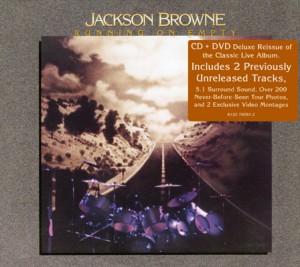Jackson Browne – Running on Empty
The Photography of Joel Bernstein: The Perfect Accompaniment to a Timeless Album
There is a wonderful moment towards the end of Woody Allen’s Manhattan when Allen’s character, a blocked writer, finds himself reflective and mildly despondent. Speaking into a tape recorder, he begins to recount the very best things in life. It’s one of my favorite films, and many is the time I’ve paused to make my own list of life’s treasures. The list is always changing, of course, but one of the few constants on my hit-parade of life is the photography of Joel Bernstein.
Like Jackson Browne, whose seminal Running On Empty tour is so strikingly and soulfully documented by Bernstein in these images. Joel is an artist with a deep-running connection to the poetry of everyday life and love. His work on the 1977 tour has rarely been seen outside the lives of the participants – it’s a painstaking and rollicking and utterly real portrait of that great trip across country. As one lucky enough to be a longtime collaborator with Bernstein. I’d seen some of these photos and proof-shets in his archives. When the time came to make a movie about my own experience in the world of early ’70s rock ‘n’ roll, Almost Famous, some of these very images were meticulously re-created in the film, partly as an homage to Joel, but mostly because inside his photography is the elixir I’d hoped would seep into the movie. The is how it felt to be there.
Years later we now live in a time when the bright lights of video cameras trail after rock ‘n’ roll like a yapping dog. Get the footage! Somewhere along the line, live concerts became like football events, complete with sideline reporters. How do you feel the game is going? There is, after all, always a concert DVD to sell… or footage to give to MTV… Somebody might want to sit at home and watch this! But when is a moment a pure moment? And when is rock ‘n’ roll – at its best, always a spontaneous outburst of truth – simply another staged moment for the cameras?
Running On Empty is about all of this, of course. And Jackson Browne knew it at the time. The howl of corporate rock was growing louder. But what of the noble aspirations of a brilliant young singer-songwriter from Orange County who set out to tilt at windmills and tell truths about the world? Did that truth reside in antiseptic studios smothered in a multitude of tracks? Or did a new song live out there on the road, growing wildly in different directions each performance, finally becoming itself on a summer night, say in Columbia, Maryland, or a hotel room in New Jersey, or a stage in Lexington, Kentucky, when the fireflies buzzed and something in the air just made everything right?
More than a live recording, Running On Empty was closer to a life recording. Much was captured on tape, in many different environments. It was also Browne’s mightiest band yet, with mainstay/spiritual warrio/masestro David Lindley still at his side. And armed with the ambitious dream of creating a living, breathing album about the road. Browne later achieved the rarest of goals: Running On Empty, made and played from the heart, became his biggest success to date.
In preparing to write this, I went back through some old files. I found a diary entry from 1977, written after Jackson and band had played the Universal Amphitheatre in Los Angeles (and recorded the version of “Love Needs A Heart” on this album). I wrote deep into the night an embarrassingly earnest letter to myself, a challenge to go deeper with my own writing. And I had a note about Joel, my good friend, who I’d watched snapping photos that night. One of his nicknames was Mr. Available Light, because he so rarely imposed an artificial environment into his work. (Even then, I’d already been on many assignments with Bernstein – me as interviewer, Joel as photographer – and we’d always honored that fly-on-the-wall ethic. We even had a moniker for our journalism, Eyes and Ears of the World. To this day, I’m Ears. He’s Eyes.) “He always finds those truthful angels,” I wrote.
I had meant to write “angles,” but the mistake was more accurate. Joel’s photos show the light, the time, the dreams, and the atmosphere… They are single-frame documentaries. Check out the details. A then-cutting-edge television behind Leland Sklar’s head in a hotel room, the handmade huarache sandals on Browne’s feet as he sits alone on a sidewalk. Lindley gloriously asleep on tour cases (couldn’t help paying homage to that one in Almost Famous), the joy overtaking Danny Kortchmar’s face as he sits with Browne on a tour bus in the afternoon, the fan-made T-shirts worn by the musicians, the way morning pushes through windows and shines its unforgiving light on sleepless young faces. The poetry of airports. The way love lives in the casual moments between good friends. It’s all here, and it all happened. As a photographer, Joel shoots like a fellow musician. (Which he is. He also sang on the tour and album.) Bernstein blends in, using all the resources of his understanding of the songs, the instruments, the subject, and the people. There is soul and movement and, most of all, music in every one of Joel’s images from the tour.
So strap in. Turn it up loud. You are cordially invited to a gallery showing, a treasure trove of personal images, the perfect accompaniment to a timeless album. This is what it looked like, and this is what it felt like. These are truthful angels.
– Cameron Crowe, Ears
Courtesy of Elektra/WEA – November, 2005


